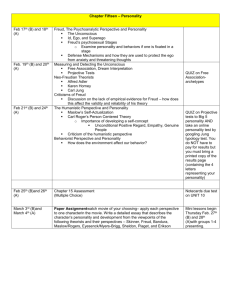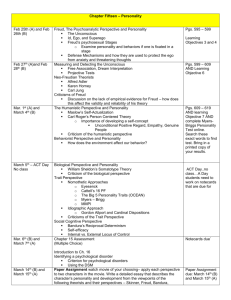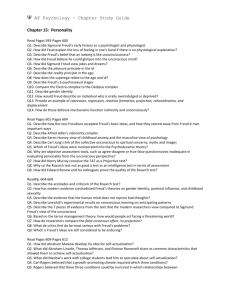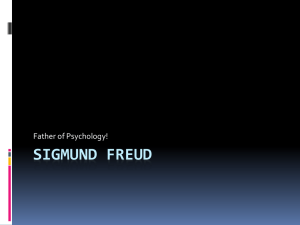AP Psychology
advertisement
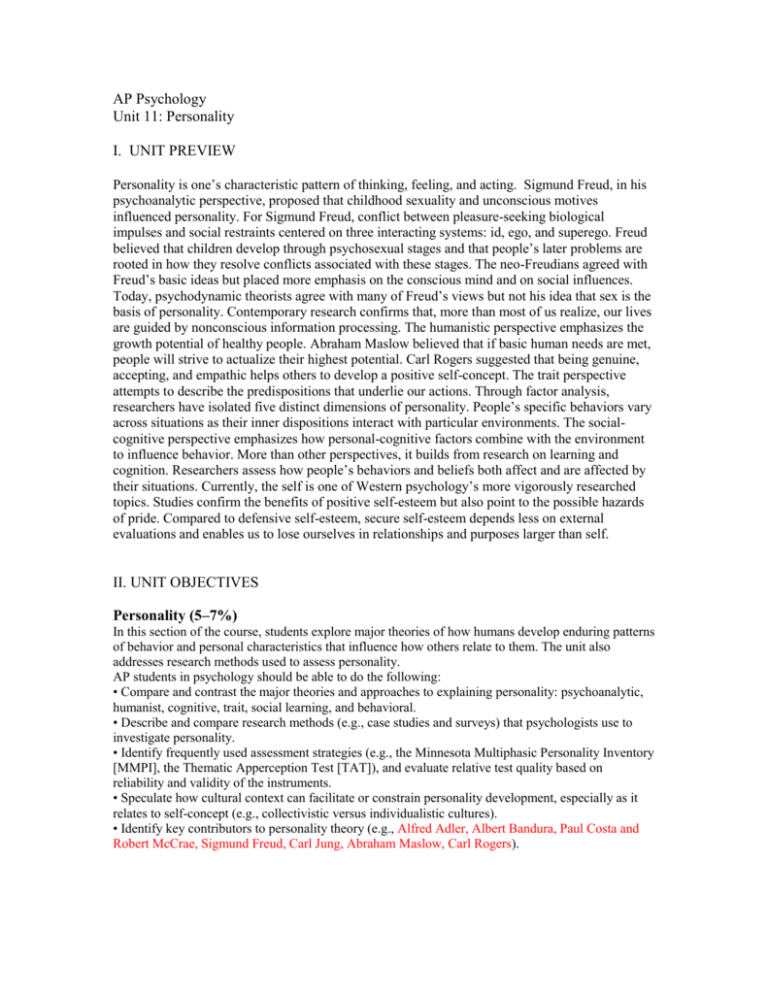
AP Psychology Unit 11: Personality I. UNIT PREVIEW Personality is one’s characteristic pattern of thinking, feeling, and acting. Sigmund Freud, in his psychoanalytic perspective, proposed that childhood sexuality and unconscious motives influenced personality. For Sigmund Freud, conflict between pleasure-seeking biological impulses and social restraints centered on three interacting systems: id, ego, and superego. Freud believed that children develop through psychosexual stages and that people’s later problems are rooted in how they resolve conflicts associated with these stages. The neo-Freudians agreed with Freud’s basic ideas but placed more emphasis on the conscious mind and on social influences. Today, psychodynamic theorists agree with many of Freud’s views but not his idea that sex is the basis of personality. Contemporary research confirms that, more than most of us realize, our lives are guided by nonconscious information processing. The humanistic perspective emphasizes the growth potential of healthy people. Abraham Maslow believed that if basic human needs are met, people will strive to actualize their highest potential. Carl Rogers suggested that being genuine, accepting, and empathic helps others to develop a positive self-concept. The trait perspective attempts to describe the predispositions that underlie our actions. Through factor analysis, researchers have isolated five distinct dimensions of personality. People’s specific behaviors vary across situations as their inner dispositions interact with particular environments. The socialcognitive perspective emphasizes how personal-cognitive factors combine with the environment to influence behavior. More than other perspectives, it builds from research on learning and cognition. Researchers assess how people’s behaviors and beliefs both affect and are affected by their situations. Currently, the self is one of Western psychology’s more vigorously researched topics. Studies confirm the benefits of positive self-esteem but also point to the possible hazards of pride. Compared to defensive self-esteem, secure self-esteem depends less on external evaluations and enables us to lose ourselves in relationships and purposes larger than self. II. UNIT OBJECTIVES Personality (5–7%) In this section of the course, students explore major theories of how humans develop enduring patterns of behavior and personal characteristics that influence how others relate to them. The unit also addresses research methods used to assess personality. AP students in psychology should be able to do the following: • Compare and contrast the major theories and approaches to explaining personality: psychoanalytic, humanist, cognitive, trait, social learning, and behavioral. • Describe and compare research methods (e.g., case studies and surveys) that psychologists use to investigate personality. • Identify frequently used assessment strategies (e.g., the Minnesota Multiphasic Personality Inventory [MMPI], the Thematic Apperception Test [TAT]), and evaluate relative test quality based on reliability and validity of the instruments. • Speculate how cultural context can facilitate or constrain personality development, especially as it relates to self-concept (e.g., collectivistic versus individualistic cultures). • Identify key contributors to personality theory (e.g., Alfred Adler, Albert Bandura, Paul Costa and Robert McCrae, Sigmund Freud, Carl Jung, Abraham Maslow, Carl Rogers). III. CONCEPTS/VOCABULARY 1. defense Mechanisms a. repression b. sublimation c. d. e. f. g. h. regression reaction formation projection rationalization displacement sublimation 2. ego 3. external locus of control 4. 5. 6. 7. 8. 9. 10. 11. 12. 13. humanistic psychology Id learned helplessness MMPI personality positive psychology projective test reciprocal determinism trait- Big Five Unconditional positive regard IV. READING QUESTIONS Chapter 15: Personality HW#1: Due Date Rd. Pg.595-Pg. 600 Q1. Describe Sigmund Freud’s early history as a psychologist and physiologist Q2. How did Feud explain the loss of feeling in one’s hand if there is no physiological explanation? Q3. Describe Freud’s belief that an iceberg is like unconsciousness? Q4. How did Freud believe he could glimpse into the unconscious mind? Q5. How did Sigmund Freud view jokes and dreams? Q6. Describe the pleasure principle in the id Q7. Describe the reality principle in the ego Q8. How does the superego relate to the ego and id? Q9. Describe Freud’s 5 psychosexual stages Q10. Compare the Electra complex to the Oedipus complex Q11. Describe gender identity Q12. How would Freud describe an individual who is orally overindulged or deprived? Q13. Provide an example of repression, regression, reaction formation, projection, rationalization, and displacement Q14. How do these defense mechanisms function indirectly and unconsciously? HW#2: Due Date Rd. Pg.601-Pg.604 Q1. Describe how the neo-Freudians accepted Freud’s basic ideas, and how they veered away from Freud in two important ways Q2. Describe Alfred Adler’s inferiority complex Q3. Describe Karen Horney view of childhood anxiety and the masculine view of psychology Q4. Describe Carl Jung’s link of the collective unconscious to spiritual concerns, myths and images Q5. Which of Freud’s ideas were incorporated into the Psychodynamic theory? Q6. Why are objective assessment tools, such as agree-disagree or true- false questionnaires inadequate in evaluating personality from the unconscious perspective? Q7. How did Henry Murray conceive the TAT as a Projective test? Q8. Why so the Rosarch test not as good a test as an intelligence test in terms of assessment Q9. How did Edward Ronow and his colleagues prove the quality of the Rosarch test? HW#3: Due Date Rd.Pg: 604-609 Q1. Describe the accolades and criticism of the Rosarch test? Q2. How has modern evidence contradicted Freud’s theories on gender identity, parental influence, and childhood sexuality Q3. Describe the evidence that the human mind does not repress bad thoughts? Q4. Describe Lewickiâ’s experimental results on nonconcious learning on anticipating patterns Q5. Describe the 7 pieces of evidence from the text that the modern researchers view compared to Sigmund Freud’s view of the unconscious Q6. Based on the terror management theory, how would people act facing a threatening world? Q7. How do researchers compare the false consensus effect, to projection? Q8. What do critics find do be most serious with Freud’s problems? Q9. Which o Freud’s ideas are still considered to be enduring? HW#4: Due Date Rd. Pg.609-Pg.612 Q1. How did Abraham Maslow develop his idea for self-actualization? Q2. What did Abraham Lincoln, Thomas Jefferson, and Eleanor Roosevelt share as common characteristics that allowed them to achieve selfactualization? Q3. What did Maslow’s work with college students lead him to speculate about self-actualization? Q4. Carl Rogers believed that a growth-promoting climate required which three conditions? Q5. Rogers believed that these three conditions could be nurtured in which relationships between people? Q6. How would a self-concept be regarded as positive? Q7. What is the changed item on the MMPI that humanistic psychologists can take satisfaction in? Q8. What are the criticisms of humanistic psychology? Q9. Why did critics object to the statement made by Carl Rogers “Am I living in a way which is deeply satisfying to me, and which truly expresses me?” Q10. How does humanistic psychology fail to appreciate the reality of our human capacity for evil? HW#5: Due Date Rd. Pg 613-Pg.615 Q1. How did Gordon Allport come to define personality? Q2. Describe the Myers-Briggs Type indicator Q3. What does the National Research Council note bout the Myers-Briggs personality test despite its popularity? Q4. How did British psychologists Hans Eysenck and Sybil Eysenk believe that we can reduce many of our normal individual variations to two or three dimensions Q5. Describe the brain-activity scans of extraverts Q6. How did Jerome Kagen exemplify temperament? Q7. Do animals have personalities, and provide examples from the text? Hw#6: Due Date Rd. Pg. 615- Pg.622 Q1. Based on the reading passage on Pg.616-pg.617, could we discern people’s traits from the alignments of the stars and planets at the time of our birth? From their handwriting, from lines on their palms? Q2. Describe the attributes of the most extensively researched personality inventory is the Minnesota Multi-phasic Personality Inventory (MMPI) Q3. Describe the criticisms of the MMPI Q4. List the five traits dimensions of the big five personality factors Q5. Describe the 4 research questions referring to the big 5 personality factors Q6. Explain the person-situation controversy Q7. Why does inconsistency in behavior make personality test scores weak predictors of behaviors? Q8. Provide evidence discussing personality stability with age Q9. Describe the three studies reported by Sammuel Gossling and his colleague demonstrating how our traits are socially significant Q10. Describe the studies of Nalini Ambady and Robert Rosenthal in video taping 13 Harvard University graduate students teaching undergraduate courses Q11. Describe the study regarding physician malpractice suits Q12. What were the conclusions derived from Bella DePaulo and her colleagues concerning people’s voluntary controls over their expressiveness Q13. Based on the experiments conducted by Maurice Levesque and David Kenny, and Peter Brorkena and his coworkers, could we size up how outgoing someone within seconds and why? Q14. Do personality traits stay stable across different situations, and provide an example of why you might agree or disagree? HW#7: Due Date Rd Pg. 622- Pg.631 Q1. Describe the beliefs of social-cognitive theorists Q2. Describe the three specific ways in which individuals and the environment interact Q3. What is the pervasive theme in psychology and in the book? Q4. Describe the two ways psychologists study the effect of personal control Q5. Describe the differences between individuals who have internal locus of control vs. individuals who display external loss of control Q6. How do Roy Baummiester and Julia Exline describe self control Q7. How does Martin Seligman demonstrate learned helplessness in dogs? Q8. Describe the famous study of nursing home patients Q9. Does increasing choice breed happier lives, and how does it explain tyranny of choice? Q10. Dhow did Seligman and Schulman explain optimism versus pessimism in professional achievement Q11. How does excessive optimism blind us to real risks Q12. Describe the ”ignorance of one’s own incompetence” phenomenon Q13. How do military and educational organizations assess behavior in situations, and describe the benefits Q14. What are the criticisms of the social-cognitive perspective?\ HW#8: Due Date Rd. Pg.631 Pg.636 Q1. How does Hazel Markus and her colleagues describe the concept of the possible selves? Q2. How does the spotlight effect attribute of people’s fear of public speaking? Q3. Describe the self-reference phenomenon? Q4. Describe some correlations between self-esteem and personal problems? Q5. Describe the results of the experiments that reveal an effect of low self-esteem Q6. How do members of stigmatized groups that have faced discrimination and lower status, maintain self-esteem? Q7. Describe the numerous findings in the text regarding our selfserving bias Q8. Describe Bushman’s and Baumeister’s experiment with the dark-side of self-esteem Q9. Describe defensive self-esteem and secure self-esteem.




